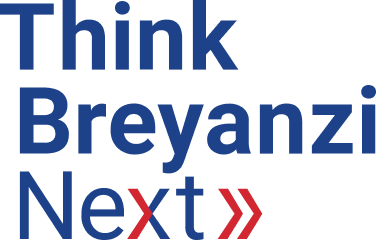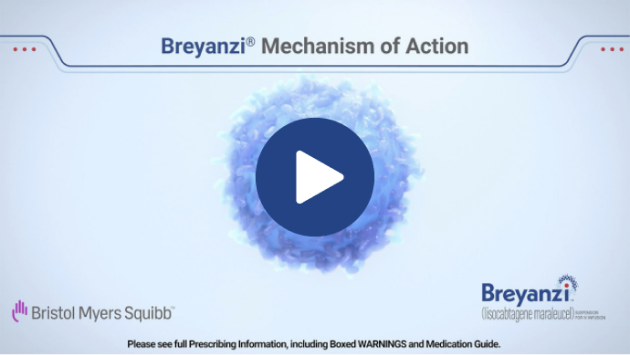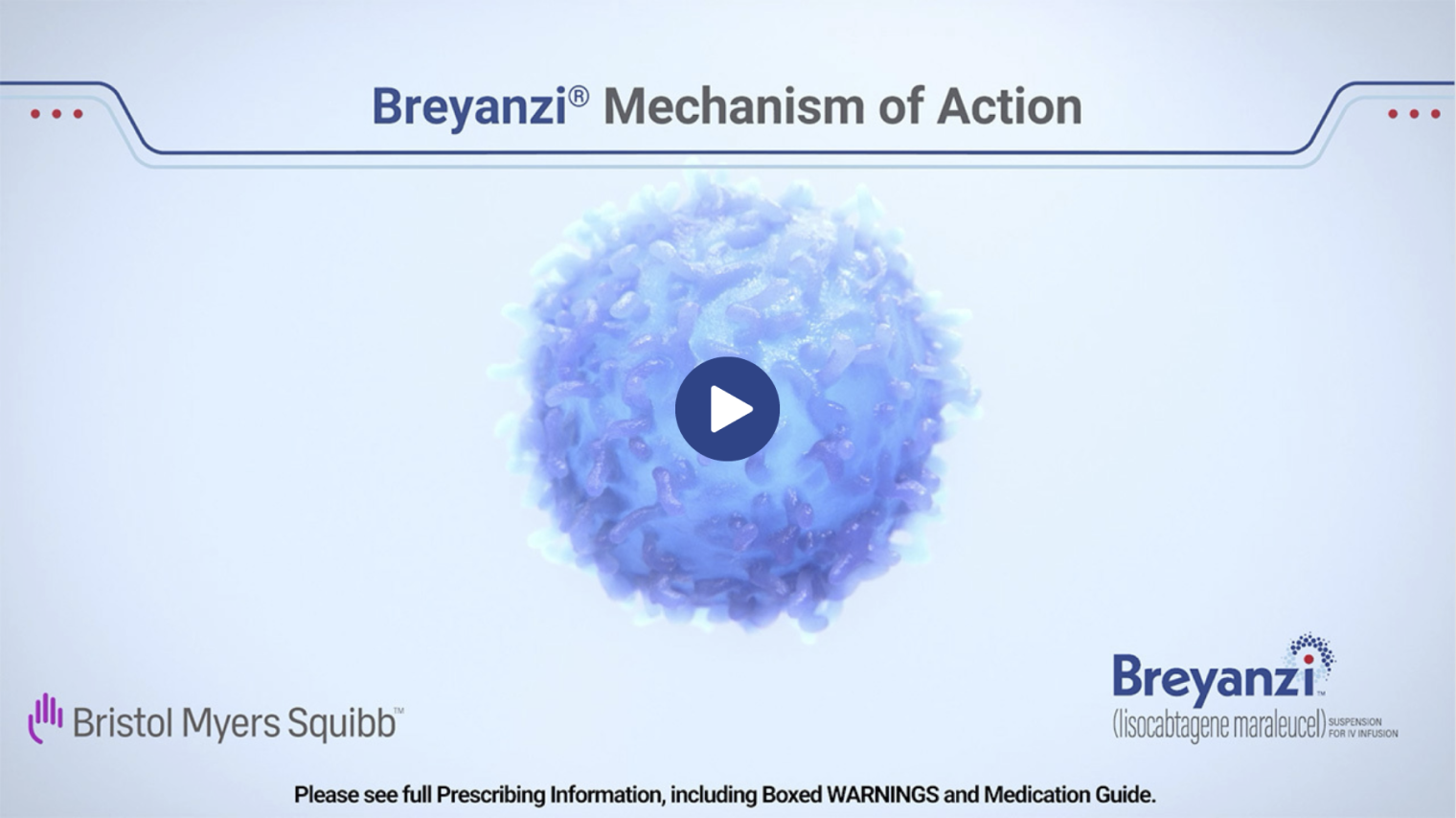- Indication
INDICATION
BREYANZI is a CD19-directed genetically modified autologous T cell immunotherapy indicated for the treatment of adult patients with large B-cell lymphoma (LBCL), including diffuse large B-cell lymphoma (DLBCL) not otherwise specified (including DLBCL arising from indolent lymphoma), high-grade B cell lymphoma, primary mediastinal large B-cell lymphoma, and follicular lymphoma grade 3B, who have:
- refractory disease to first-line chemoimmunotherapy or relapse within 12 months of first-line chemoimmunotherapy; or
- refractory disease to first-line chemoimmunotherapy or relapse after first-line chemoimmunotherapy and are not eligible for hematopoietic stem cell transplantation (HSCT) due to comorbidities or age; or
- relapsed or refractory disease after two or more lines of systemic therapy.
Limitations of Use: BREYANZI is not indicated for the treatment of patients with primary central nervous system lymphoma.
- US Full Prescribing Information
- Prep and Administration
- BMS Connect
- REMS
- Patient Site
- This site is intended for US healthcare professionals only.
Process: Smart from the start
Help outsmart LBCL with earlier use of Breyanzi® CAR T cell therapy1
Think Breyanzi next at the first sign of relapse.1
- Consult with a CAR T cell therapy treatment center as soon as a patient relapses to prevent delays in care
The first step in the process is to select an appropriate patient for Breyanzi.
Early identification of appropriate patients and collaboration with a CAR T cell therapy treatment center are key.

Initiation1
Once a potential patient is identified, the certified Breyanzi treatment center confirms the patient's eligibility, and the enrollment process is initiated.1
Because of the risk of CRS and neurologic toxicities, Breyanzi is available only through a restricted program under a Risk Evaluation and Mitigation Strategy (REMS) called the Breyanzi REMS.
Certified treatment centers have undergone safety management training and are enrolled in the Breyanzi Risk Evaluation and Mitigation Strategy (REMS) program. Once you find the most appropriate treatment center, your patient will be evaluated for enrollment.
Breyanzi is a one-time treatment with options to be administered in an inpatient or outpatient setting.1*
Additional support for referrers, transplanters, patients, and caregivers is accessible at celltherapy360.com to help patients along the treatment journey
Breyanzi is currently offered at certified treatment centers across the United States, and more may continue to be added
CAR, chimeric antigen receptor; LBCL, large B-cell lymphoma.
*Treatment process includes leukapheresis, manufacturing, administration, and adverse event monitoring. A single dose of Breyanzi is 90 to 110 × 106 CAR-positive viable T cells for LBCL after 1 line of therapy, and 50 to 110 × 106 for LBCL after 2 or more lines of therapy (consisting of 1:1 CAR-positive viable T cells of the CD8 and CD4 components), with each component supplied separately in 1 to 4 single-dose vials.
Breyanzi manufacturing1
LEUKAPHERESIS
T cells are collected via leukapheresis at a qualified center.1
MANUFACTURING
Cells are sent to a manufacturing site for purification, engineering, and expansion delivering a defined ratio of CAR-positive viable T cells (consisting of 1:1 CD8 and CD4 components). Ensure that patients understand the risk (11%) of manufacturing failure. Rates of manufacturing failure in the commercial setting differ from rates in the clinical trial.1
INFUSION
Breyanzi is delivered as separate vials of CD8-positive and CD4-positive cells. Lymphodepletion chemotherapy (fludarabine 30 mg/m2/day and cyclophosphamide 300 mg/m2/day concurrently for 3 days) should be completed 2 to 7 days before administration of Breyanzi.1
A single dose of Breyanzi contains 50 to 110 × 106 CAR-positive viable T cells (consisting of 1:1 CAR-positive viable T cells of the CD8 and CD4 components). The manufacturing target dose is 100 × 106 CAR-positive viable T cells.
Physician is notified of estimated Breyanzi availability date, which is subject to change. Confirm availability before starting lymphodepletion.1
MONITORING
Monitor patients daily at a certified healthcare facility during the first week following infusion for signs and symptoms of CRS and neurologic toxicities.
Instruct patients to remain within proximity of the certified healthcare facility for at least 4 weeks following infusion.1
LEUKAPHERESIS T cells are collected via leukapheresis at a qualified center.1
MANUFACTURING Cells are sent to a manufacturing site for purification, engineering, and expansion delivering a defined ratio of CAR-positive viable T cells (consisting of 1:1 CD8 and CD4 components). Ensure that patients understand the risk (11%) of manufacturing failure. Rates of manufacturing failure in the commercial setting differ from rates in the clinical trial.1
INFUSION Breyanzi is delivered as separate vials of CD8-positive and CD4-positive cells. Lymphodepletion chemotherapy (fludarabine 30 mg/m2/day and cyclophosphamide 300 mg/m2/day concurrently for 3 days) should be completed 2 to 7 days before administration of Breyanzi.1
A single dose of Breyanzi is 90 to 110 × 106 CAR-positive viable T cells for LBCL after 1 line of therapy, and
50 to 110 × 106 for LBCL after 2 or more lines of therapy (consisting of 1:1 CAR-positive viable T cells of the CD8 and CD4 components). The manufacturing target dose is 100 × 106 CAR-positive viable T cells.1
50 to 110 × 106 for LBCL after 2 or more lines of therapy (consisting of 1:1 CAR-positive viable T cells of the CD8 and CD4 components). The manufacturing target dose is 100 × 106 CAR-positive viable T cells.1
Physician is notified of estimated Breyanzi availability date, which is subject to change. Confirm availability before starting lymphodepletion.
MONITORING Monitor patients daily at a certified healthcare facility during the first week following infusion for signs and symptoms of CRS and neurologic toxicities.
Instruct patients to remain within proximity of the certified healthcare facility for at least 4 weeks following infusion.1
Follow-up1
Post-infusion monitoring: After at least 4 weeks of post-infusion monitoring, patients require long-term monitoring and appointments.1
Advise your patients to avoid driving or operating heavy or potentially dangerous machines for at least 8 weeks following their Breyanzi infusion.1
- Continue to monitor for signs and symptoms of CRS and NT. Evaluate and treat promptly
- Continue to monitor CBC and watch for signs and symptoms of serious infections, febrile neutropenia, prolonged cytopenias, B-cell aplasia, hypogammaglobulinemia, and secondary malignancies
- Monitor lifelong for secondary malignancies. In the event that a secondary malignancy occurs, contact Bristol Myers Squibb at 1-888-805-4555 for reporting and instructions
CAR, chimeric antigen receptor; CBC, complete blood counts; CRS, cytokine release syndrome; LBCL, large B-cell lymphoma; NT neurolgic toxicity.
Patients may be enrolled in the Breyanzi registry, which will
monitor safety for up to 15 years. Patients should also be monitored lifelong for potential secondary malignancies
Breyanzi® is designed for gradual expansion* and persistence1
Smart engineering: Breyanzi is a CD19-directed CAR T cell therapy1
Breyanzi was present in the peripheral blood for up to 2 years1
Breyanzi binds to CD19 expressed on the cell surface of tumor and normal B cells, inducing activation of CAR T cells and killing target cells.1


The binding region of the CAR is composed of a CD19-directed, antibody-derived, single-chain variable fragment.1
CAR, chimeric antigen receptor.
* The median time of maximal expansion in peripheral blood occurred 12 days after infusion.
† The purified CD8-positive and CD4-positive T cells are separately activated and transduced with the replication-incompetent lentiviral vector containing the anti-CD19 CAR transgene.
‡ Treatment process includes leukapheresis, manufacturing, administration, and adverse event monitoring. A single dose of Breyanzi contains 90 to 110 × 106 CAR-positive viable T cells for LBCL after 1 line of therapy, and 50 to 110 × 106 for LBCL after 2 or more lines of therapy (consisting of 1:1 CAR-positive viable T cells of the CD8 and CD4 components), with each component supplied separately in 1 to 4 single-dose vials.
* The median time of maximal expansion in peripheral blood occurred 12 days after infusion.
† The purified CD8-positive and CD4-positive T cells are separately activated and transduced with the replication-incompetent lentiviral vector containing the anti-CD19 CAR transgene.
‡ Treatment process includes leukapheresis, manufacturing, administration, and adverse event monitoring. A single dose of Breyanzi contains 90 to 110 × 106 CAR-positive viable T cells for LBCL after 1 line of therapy, and 50 to 110 × 106 for LBCL after 2 or more lines of therapy (consisting of 1:1 CAR-positive viable T cells of the CD8 and CD4 components), with each component supplied separately in 1 to 4 single-dose vials.



